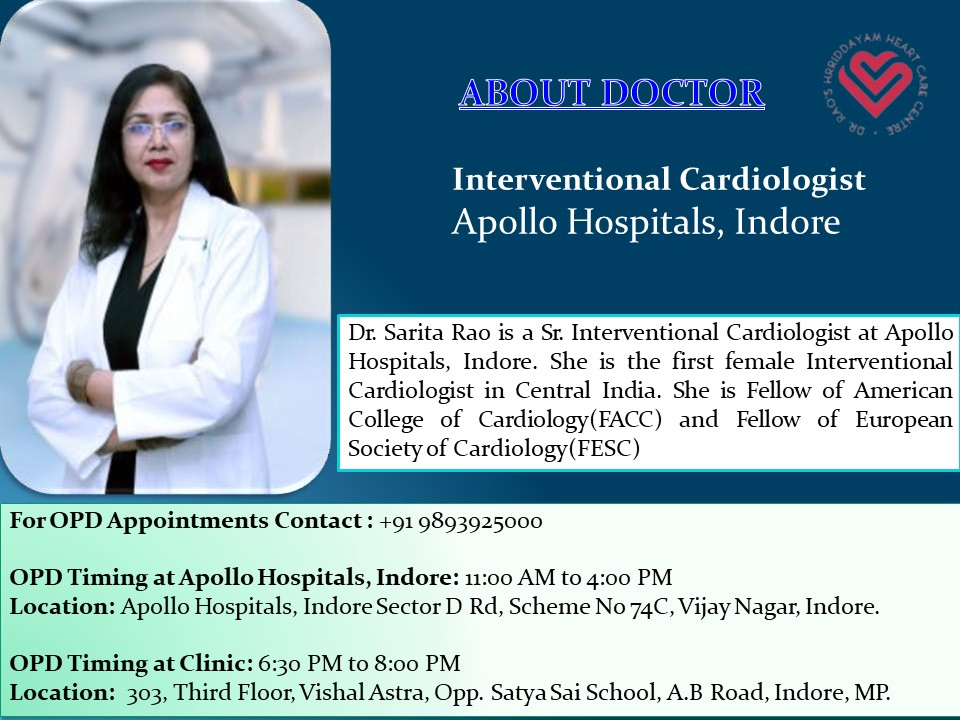All about the ventricular septal defect - PowerPoint PPT Presentation
Title:
All about the ventricular septal defect
Description:
Dr. Sarita Rao is a Top cardiologist in Indore, If you are looking for best cardiologist in Indore, book an appointment with Dr. Sarita Rao right away. Visit our site for more details - – PowerPoint PPT presentation
Number of Views:2
Title: All about the ventricular septal defect
1
ABOUT DOCTOR
Interventional Cardiologist Apollo Hospitals,
Indore
Dr. Sarita Rao is a Sr. Interventional
Cardiologist at Apollo Hospitals, Indore. She is
the first female Interventional Cardiologist in
Central India. She is Fellow of American College
of Cardiology(FACC) and Fellow of European
Society of Cardiology(FESC)
For OPD Appointments Contact 91
9893925000 OPD Timing at Apollo Hospitals,
Indore 1100 AM to 400 PM Location Apollo
Hospitals, Indore Sector D Rd, Scheme No 74C,
Vijay Nagar, Indore. OPD Timing at Clinic 630
PM to 800 PM Location 303, Third Floor, Vishal
Astra, Opp. Satya Sai School, A.B Road, Indore,
MP.
2
All about the ventricular septal defect
A ventricular septal defect occurs when the wall
that grows between the two ventricles does not
develop normally during pregnancy. One kind of
congenital heart problem is a ventricular septal
defect. Some medical conditions are present at
birth and are considered congenital.
In a healthy newborn, blood low in oxygen is
pumped to the lungs by the right side of the
heart, while blood high in oxygen is pumped out
to the rest of the body by the left side.
When a baby is born with a ventricular septal
defect, blood can flow back and forth between the
two ventricles, usually from the left ventricle
to the right ventricle and then into the lungs.
The increased oxygenated blood flow strains the
cardiovascular system, particularly the heart and
lungs. This abnormality can lead to various
severe problems, including heart failure,
pulmonary hypertension, arrhythmia, and stroke.
Symptoms
Severe heart defects frequently manifest within
the first few weeks or months of a child's
existence. An infant with a ventricular septal
defect (VSD) may show poor feeding and failure to
grow.
3
- A rapid heartbeat or shortness of breath
- Weaknesses Tires quickly
A ventricular septal defect may not show symptoms
to you or your doctor right after birth. If the
abnormality is minor, it may not cause noticeable
symptoms until later in infancy. The severity of
the hole and the presence of any additional
cardiac abnormalities affects the severity of the
symptoms.
During a routine visit, if your doctor detects a
heart murmur when listening to your baby's heart
using a stethoscope, they may first suspect a
heart problem. Ultrasounds can sometimes pick up
on a VSD before a baby is born.
4
It's not uncommon for a VSD to go undetected
until a person is an adult. Symptoms and signs
may include shortness of breath or a cardiac
murmur heard by a medical professional's
stethoscope.
Types of VSD
Four VSD kinds differ in location and hole
structure (or holes). VSDs include-
Membranous - This constitutes 80 of VSD cases.
VSDs occur in the upper ventricle wall.
Muscular- About 20 of baby VSDs have several
holes.
Inlet- This hole occurs below the right
ventricle's tricuspid and left ventricle's mitral
valves. Blood entering the ventricles must pass
via a VSD.
Conoventricular- This VSD produces a hole between
the right and left ventricles before the
pulmonary and aortic valves. Blood must pass
through both valves via the VSD.
Treatments
The severity of the hole and the associated
health issues determine the course of treatment
for a ventricular septal defect. If the hole in
the ventricular septum is tiny and not producing
5
any symptoms, the doctor will monitor the infant
closely to look for signs of heart failure and
ensure the hole closes on its own. Further
intervention may be required if the hole is too
large or does not shut on its own.
Cardiac catheterization or open-heart surgery may
be recommended to repair the hole and restore
normal blood flow, depending on the extent of the
hole, symptoms, and the child's overall health.
Following repairing a ventricular septal defect,
patients will need to return to the clinic
frequently to ensure that the opening has
adequately healed. In most cases, children born
with a ventricular septal defect that closes
(either naturally or surgically) go on to lead
everyday, healthy lives.
Medicines
Some children will require medication to help
with heart muscle strength, blood pressure
reduction, and fluid loss.
Nutrition
Babies with VSD may experience fatigue while
breastfeeding, resulting in inadequate nutrition.
A high-calorie formula might be recommended to
ensure that infants acquire weight healthily.
Babies can get exhausted during breastfeeding,
which can necessitate the use of a feeding tube.
6
Dr. Sarita Rao is a Top cardiologist in Indore,
If you are looking for best cardiologist in
Indore, book an appointment with Dr. Sarita Rao
right away. Visit our site for more details -
https//drsaritaraocardiologist.com/
Please go visit our social media Facebook -
https//www.facebook.com/Dr-Sarita-Rao-Cardiologis
t-101841215429014 Please do follow on Instagram
Instagram - https//www.instagram.com/drsarita
_rao/ To More Post - All about rheumatic heart
disease































